My First Spider-Man, 2003
Welcome to my nightmare.
That’s a very specific reference requiring explanation. Whenever I’m at peak productivity and pressure is highest, my dreams typically become a continuation of my work day. Things get really screwy there. When I had a full-time comic book career, I would often have dreams about being over-committed. They were always the same; I’d agreed to one project too many, and that one project was constantly being pushed aside until it became an emergency. That one project was invariably a Spider-Man comic. Every time.
I have no idea why my mind went there. I’ve never missed a deadline in my life, and I didn’t have an ambition to draw a Spider-Man comic book. Nevertheless, being desperately behind on one was consistent nightmare fuel until I got out of comics and into TV animation. Then in 2002, I got hired to work on my first Spider-Man cartoon. It was my nightmare come to life, in the best possible sense.
I say “first” because I’ve also worked on every Spider-Man cartoon made since then. A total of six different incarnations ranging from 2002 to 2020. After all that, I’m willing to bet that I’ve drawn the character more times than any comic book artist in history. Fortunately, I didn’t have to put all those webs on him. The wall crawler and I will probably meet again somewhere down the road. He’s the most recognized comic book character on Earth (ahead of both Batman and Superman, according to internal Marvel data), so there will always be an impetus to put him on TV.
As for this particular version, it was a helluva show for anyone to start with. It was in development as Sam Raimi was making the movie starring Tobey Maguire. It was greenlit for production in the fall of 2001, bringing me back to Sony Animation Studio after an 8-month hiatus (in which I drew my first Grease Monkey graphic novel). It was my fourth series under Supervising Producer Audu Paden. But Sony was just one of three overlords this time; the other two were Marvel and MTV. It was simply called Spider-Man at that point, but would later be marketed under the title Spider-Man: The New Animated Series (hereafter, TNAS).
To my initial disappointment, I was not being brought on as a director, even though I’d been directing for four years straight by that point. But things evolved pretty quickly once our feet hit the ground, and I was elevated back up to where I belonged within the first month or two. It was another case of underestimating the obstacles and needing to adjust plans on the fly. That was to become a theme for this production, as you’ll see.
The show broke new ground with a form of CG animation commonly called “toon shader.” Rather than fully rendering the characters and objects, this technique would outline and fill them with flat colors to imitate 2D animation. It hadn’t been done before on this scale (13 episodes) and it took a lot of innovation to work out the kinks. The CG studio that landed the gig was Mainframe, which had previously handled Starship Troopers and Heavy Gear. But none of that involved me. My job, as always, was to turn written words into drawings. It was my second CG show after Heavy Gear, so the “culture shock” of that world was thankfully behind me.
The crew consisted of four directors (plus Audu) and somewhere around a dozen storyboard artists. I’ve often been asked what a director actually does on an animated show, so this seems like a good place to unload some intel on the subject.
My first and most important duty is to re-engineer the script. I don’t have the authority to change the story, but I make decisions about the most practical and effective ways to visualize it. Usually that means rethinking or clarifying action for the artist who has to draw it. Scriptwriters don’t always know our limitations, so sometimes they overreach in their descriptions. Or maybe a set design isn’t quite compatible, so the action has to be rewritten. Or maybe the writer asked for an army of extras when in fact we can only put four of them onscreen at a time. I have to take all those things and many more into account when preparing a script for storyboarding. When I’m done, it’s what we call “animation friendly.”
Next, I determine how to divide up the script between myself and my crew for storyboarding. I parcel it out so that (A) everyone gets an equal workload, (B) they each get something appropriate to their skill level, and (C) nobody gets saddled with all the hard stuff. We talk through the segments and the drawing begins.
Those segments get passed back and forth over the next month or so. I’ll review a rough board, give revision notes (usually in the form of new drawings) and when all the shots are accounted for it goes into a cleanup phase. We don’t have to draw every detail, but we have to make sure all the shapes, proportions, and compositions are accurate. We’re essentially making a blueprint for the animators to follow. If they happen to be in a non-English speaking country, the drawings have to communicate a LOT. Precision is vital.
In film terms, a storyboard artist is a stage manager, camera operator, and lighting engineer all in one. Instead of coaching the actors, we draw them. As the director, I make sure everything properly fits together into the finished product. In sports terms, I’m a quarterback on the field with my team, and our goal is to reach the end zone. Our opponent is the budget and the calendar. This is equally true whether the show is 2D or CG.
Everything goes pretty smoothly until you start getting revision notes from above. That’s when your carefully-made plans begin to unravel, because you usually get hit with them when you’re mired in your next episode. There isn’t enough time left in the cycle to make revised drawings look as good as the rest of the storyboard, so they tend to stand out like sore thumbs. You’ll see plenty of them in the samples I’ve included below. As artists, we want everything to look as good as possible. The calendar has other priorities.
While we were hard at work, the Spider-Man movie came out in April 2002 and was an instant hit. I saw it right away and loved it. Finally, a Marvel film that measured up to the ’78 Superman. It hasn’t aged as well, but only because we’ve gotten better ones since then. It surprised everyone by earning over $100 million in its opening weekend, so the stakes for our little carnival suddenly went through the roof. We were now making a followup for one of the biggest movies of all time. We’d been through crazy productions before, but nothing prepared us for this.
Usually, studio battles go on at a level far above where the work actually takes place. Exec Producers fight over a script until somebody wins, then that script is handed over to us. It’s mostly hands-off from above until we’ve got an animatic ready, then they weigh in with notes and changes. We process those, pushing back on the ones we disagree with, then the storyboard gets done and goes to the animators. Upper management doesn’t have much involvement in our day-to-day labors. TNAS was a distinct exception to that rule.
Recall that there were three entities in charge of the project: Sony (licensor), Marvel (IP holder) and MTV (broadcaster). Those were some big egos at the table right from the beginning, but after opening weekend no single meeting room could contain them.
There’s a common phenomenon in TV, which I call the “fingerprint race.” Executives at a certain level want to get their fingerprints on a new project so they can take credit if it’s a hit – but not too much, in case it’s a flop. When multiple execs do this simultaneously, and in competition with each other, we get terms like “development hell.” But there’s a point where development stops and they all do a slow fade into the background. After the first few episodes of a series, they usually lose interest and move on, making production easier for those of us on the ground. (If you happen to land a second season, it gets MUCH easier.)

But imagine what happens when your subject matter suddenly becomes the world’s hottest potato. The executives come roaring back in, intent on pressing those fingerprints as deep as they will go. And when you’ve got three giant egos battling each other for creative control, something’s got to give.
Something did. They battled each other to a standstill. Nobody had veto power to settle the fight. Until they could find a way out of their mutual deadlock, the show was frozen in place. We still had to report in every day and we continued getting paid, but we couldn’t continue working on episodes. Audu Paden took advantage of this by shifting us to R&D mode, inventing projects that would be helpful to the show once it got moving again. As an immediate consequence, one entire episode that had been completely boarded was scrapped, never to be seen by anyone. I wish I’d kept that board, because it would be a real jewel to share with you now.
One of my assignments was to create a catalog of web-swinging scenes that could be plugged in wherever they might fit. They were helpful not just to this show, but to a subsequent one ten years later. I kept the unused shots just for kicks, then hauled them back out of the vault for Ultimate Spider-Man in 2011. They fit perfectly and saved me a bunch of time.
Another assignment was to create faux storefronts for our New York City set. I spent a day out of the studio sketching buildings, then designed flat images that could be pasted into backgrounds. I don’t remember if they actually got into the show, but it was a good idea.
We were in this holding pattern for an unbelievable two months. We took long lunches, saw movies, and played video games while the executives duked it out. When that two month period was up, the “hiatus” budget ran out and we were all laid off for two weeks.
When we finally came back in, we learned that a new showrunner had been chosen to oversee us. Morgan Gendel was an amiable fellow from the live-action world, miraculously capable of mediating all three of our parent companies. We all liked him and got along fine. Once the show started up again, it was business as usual. Oddly, Morgan had to depart after a couple months due to larger commitments, but we got along fine in his wake with no further work stoppage from the executive suite. Maybe that negotiation finally took all the fight out of them. (More likely, they just lost interest and moved on like usual.)
Several luminaries were involved at various levels. Brian Michael Bendis (a Marvel writer) participated in development. Neil Patrick Harris was the voice of Peter/Spidey, and I talked with him in one of the DVD commentaries. (At the time, he was still just Doogie Howser to me.) Other notable names in the voice cast were Stan Lee, Lisa Loeb (Mary Jane), Ian Ziering (Harry Osborn), Michael Clarke Duncan (reprising his Kingpin from the Daredevil movie), Keith Carradine (J. Jonah Jameson), Rob Zombie (Curt Connors), Gina Gershon (Shikata), Michael Dorn (Kraven), Virginia Madsen (Silver Sable), Ed Asner, Kathy Griffin, Jeremy Piven, and Jane Lynch (who should be in everything). MTV wanted some music talent in the cast, which led to the discovery that being a good singer doesn’t necessarily make you a good actor.
On the technical side, it was my first widescreen series. Up until then, all the shows I worked on were in the old 4X3 aspect ratio. Our storyboards were still drawn in 4X3, so the animation studio simply extended the image field on the sides. It was a big deal back then to have the entire island of Manhattan built in CG. It had a few “hotspots” with enough detail to serve as “hero” locations. It was an expensive, data-heavy investment intended to pay for itself over multiple seasons. But in the end we only got to do one.
I’m still not quite sure why the show didn’t continue despite the phenomenal success of the franchise. I only recall some vague hints about lawsuits keeping it locked up in court. (The takeaway: sometimes it actually doesn’t pay to be successful.) Sony’s next effort, Spectacular Spider-Man, wouldn’t appear until 2008. I worked on that one, too. I was the only TNAS veteran on the crew, which makes me the only artist to have worked on every Spidey show from 2001 to 2020.
My own personal opinion of TNAS was that the writing, acting and storyboarding were all great, but the character animation was a poison pill. It pains me to say that, because a lot of talented people worked really hard on it, but I could never get past its shortcomings. Distorted bodies, painted-on costumes, and unattractive faces made it hard on the eyes (examples below). Again, I don’t want to denigrate the effort – which was heroic – but these were all choices I wouldn’t have made.
After that, Spider-Man remained firmly in the 2D realm until the most recent version, Spidey and his Amazing Friends, a preschool show currently streaming on Disney+. Yep, I worked on that one, too. It was just as crazy as TNAS, which makes me think CG itself may be the real villain here. This time it went even farther and killed the studio I was working for. But I’ll save that story for another day.
TNAS debuted Friday nights on MTV July 2003 and ran through September. The airdates for the episodes did not match their production order, then they got further scrambled on the DVD release. But that seems to have become the official order, so it’s reflected below.
All the episodes are available on a 2-DVD set (2004) and streaming on Amazon Prime, Apple TV and Betaseries, and Disney Plus as of October 2022.
THE EPISODES
I directed two out of the thirteen (indicated in red) and did storyboards for nine others (indicated in blue), which left only two that I didn’t touch. The season ends on a cliffhanger with Peter giving up on being Spider-Man. This happened numerous times in the comics, but since we didn’t get a second season I guess this was the one time it stuck.
1. Heroes & Villains
Spider-Man battles Turbo Jet, a modern-day Robin Hood armed with a homemade propulsion system, who steals from the wealthy and gives to the poor. But he accomplishes this by committing crimes and he refuses to let anyone stop him, even Spider-Man.
Produced as Episode 6
Watch it here
See the complete storyboard and animatic below
2. Royal Scam
Spider-Man is duped by the infamous Kingpin into stealing the TX-1 super-chip, designed to decrypt the confidential satellite transmissions that drive the world’s financial markets. Now he must find a way to get it back.
Produced as Episode 5
3. Law of the Jungle
Peter’s professor, Dr. Curt Connors, injects himself with reptilian DNA, which slowly changes him into the angry, vengeful Lizard. As the serum affects Connors’ brain, Spider-Man must stop his beloved professor as he begins seeking revenge on those who have harmed him – including Harry!
Produced as Episode 8
Watch it here
See my segment here (starts at 1:08)
See my storyboard below
4. The Sword of Shikata
Richard Damien has an interest in rare animals and hires martial arts expert Shikata to capture the next addition to his collection: Spider-Man. But Shikata makes different plans for the webslinger after their first confrontation and plans for a fight to the death.
5. Keeping Secrets
Spider-Man is out to catch Talon, a female thief behind a series of high-risk robberies. Things get complicated when Spidey learns Talon’s true identity – she’s Harry’s new girlfriend.
6. Tight Squeeze
Three ex-KGB agents, now a team of mercenaries called Pterodax, take a group of people hostage, including Peter and his new crush Indy. Their demand is simple; they want Spider-Man! Peter will need to use his cunning and cleverness to figure out a way to appease them without revealing his alter-ego.
Produced as Episode 4
Watch it here
See my segment here
See my storyboard below
7. Head Over Heels
Peter Parker’s lab partner Christina reads his mind with her new invention, an ESP crown. The crown malfunctions, jolting her own brain with electricity and affecting her sanity. No longer able to distinguish fantasy from reality, she now thinks Spider-Man is communicating with her and is bent on doing whatever it takes to be with him.
Not found online
8. The Party
Peter Parker’s nerdy high-school friend Max Dillon is hazed in a deadly fraternity prank that turns him into Electro, a high-voltage villain that threatens the campus. Only Spider-Man can stop him from exacting his revenge on his tormentors.
Produced as Episode 1
Watch it here
Watch my segments here and here
9. Flash Memory
Peter Parker’s high school nemesis, Flash Thompson, is used in an illegal experiment to increase intelligence. Now, the usually thick-headed jock has an intelligence to rival Peter’s! While this is happening, Spider-Man has to deal with two thugs that already got the same brain-boost.
Produced as Episode 10
Watch it here
See the complete animatic below
10. Spider-Man Dis-Sabled
Peter covers a press conference and inadvertently videotapes incriminating evidence against Silver Sable, an Eastern European assassin for hire. Now she will stop at nothing – including killing Mary Jane, Harry, and Indy – to get the tape back.
Not found online
11. When Sparks Fly
Max Dillon/Electro resurfaces and makes contact with Sally, a girl he fell in love with before his transformation. He wants to be with Sally and decides the only way to do that is to make her undergo a similar transformation.
Not found online
12. Mind Games Part 1
The Gaines Twins, a brother and sister with uncanny telepathy, escape from an armored transport convoy, but Spider-Man apprehends them by overcoming their brain blasts with his own superhuman will power. Later, just as Spider-Man is about to reveal his secret identity to MJ, Kraven the Hunter confronts him. As payback for the years he spent in jail, Kraven attacks MJ with one of his poison darts. Spider-Man rushes to her side too late, as her life slowly slips away. Now, Peter is out for revenge.
Produced as Episode 12
13. Mind Games Part 2
Spider-Man realizes that the diabolical Gaines Twins have brain-blasted him into believing that MJ has died at the hands of Kraven the Hunter. He corners the Twins, but things take a turn for the worse when they once again use their telepathy to trick him. This time Indy is seriously wounded. The guilt causes Peter to throw his costume away and quit his career as a crime-fighter. Is this the end of Spider-Man, or a new beginning for Peter Parker?
Produced as Episode 13
Various clips
Badass moments (7:15)
Battle scenes (14:00)
mostly my stuff up to 8:30
Peter and Indy moments (7:45)
Suit-up scenes (2:19)
Dark moments (15:44)
Swinging scenes (6:00)
Important fights (39:00)
LINKS
Twitter page for fan-made sequel
Youtube reviews: Review 1 | Review 2 | Review 3
CBR article: Every Spider-Man series in order
MY ARCHIVE
Tight Squeeze Act 3 storyboard
Heroes & Villains animatic
This is the entire episode from start to finish, which will show you (A) how many individual storyboards were needed, (B) different drawing styles of different artists, and (C) what a “conformed” storyboard looks like with all its revisions indicated. It can get pretty sloppy.
Trivia: the villain in this episode was called Blue Streak in the script, then later evolved into Rocket Racer and finally Turbo Jet (A.K.A. Louis Wyler). This was because the edict from Marvel was that if a character design changed significantly from the comics, they should just become a new character. We were happy to follow that edict. I took part in the design development; see my versions below in the design section.
Law of the Jungle Act 3 storyboard
Flash Memory animatic
Design collection
BONUS: In case you thought the headline for this article referred to the first Spider-Man comic book I ever read, it was issue 142 (at left), published in March 1975 when I was coming up on 10 years old. This led me into the now-famous Gwen Stacy clone saga, the debut of Tarantula, and the mind-bending issue 150 when Spidey questions his own sanity. That was quite a rollercoaster to start off with.

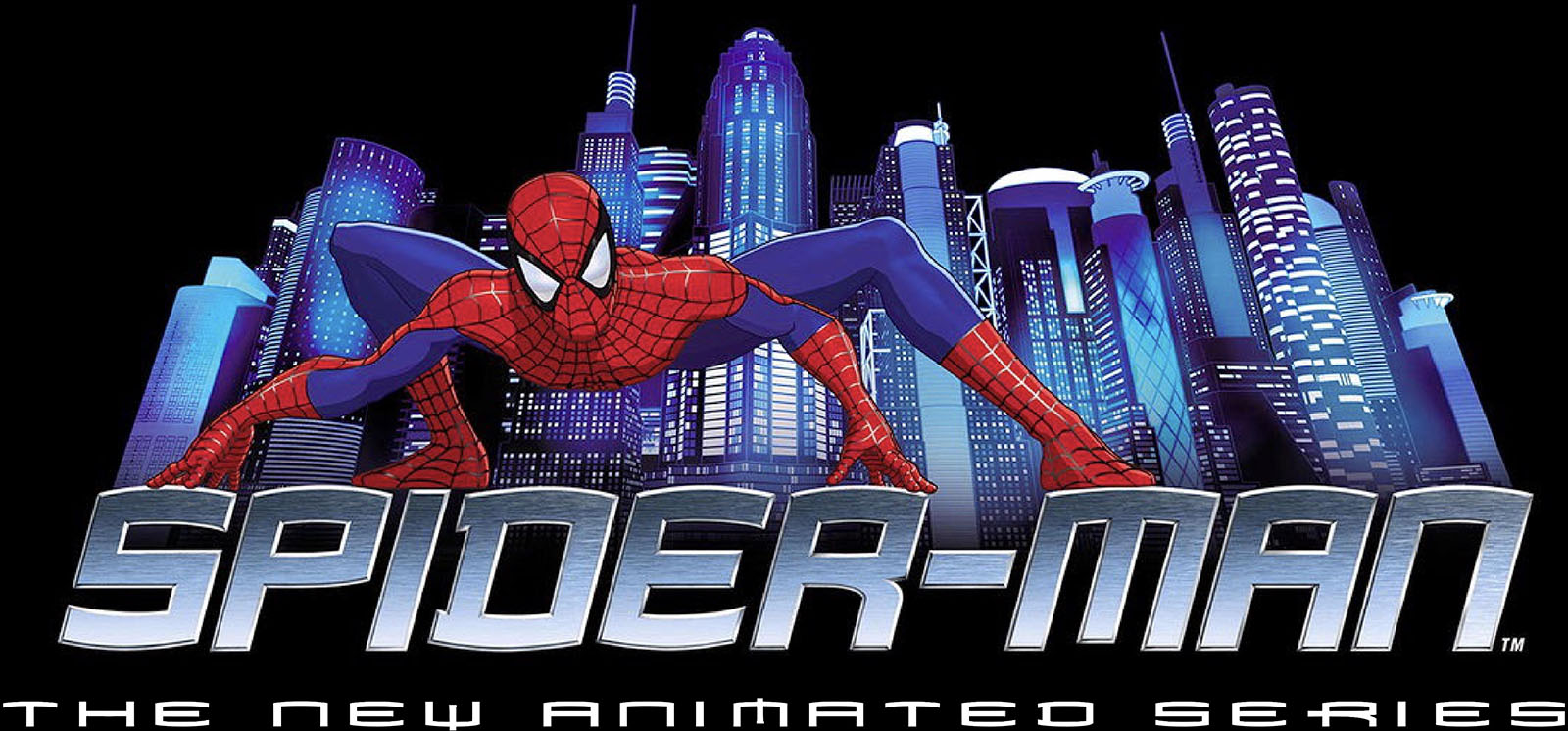
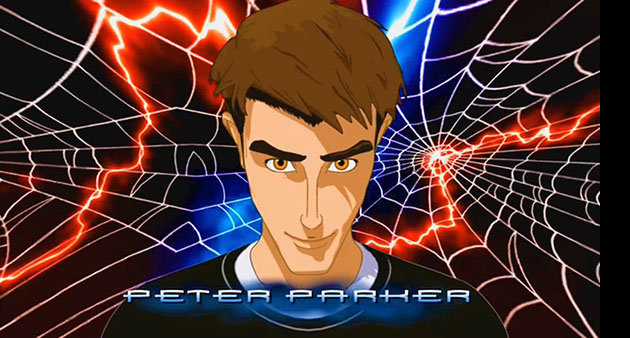
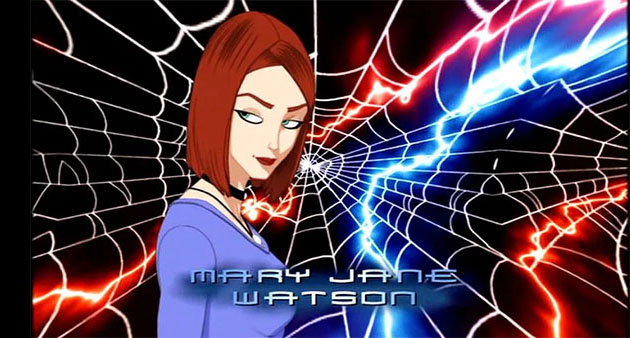
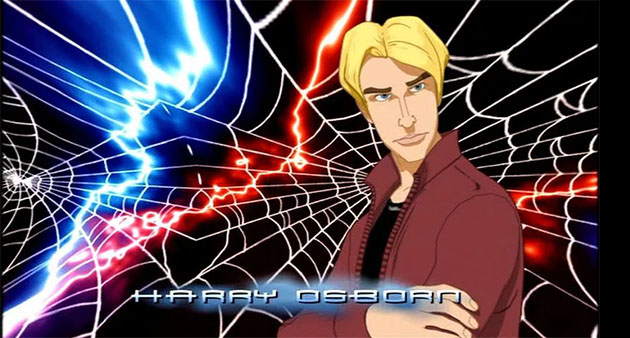

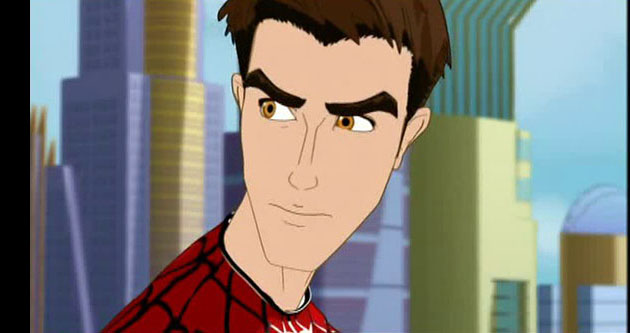
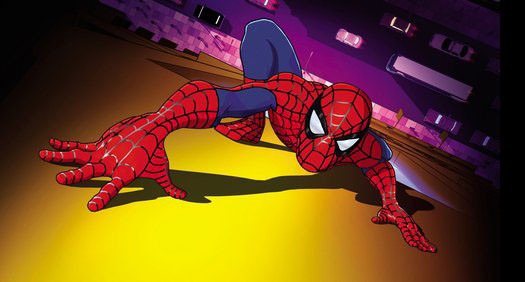
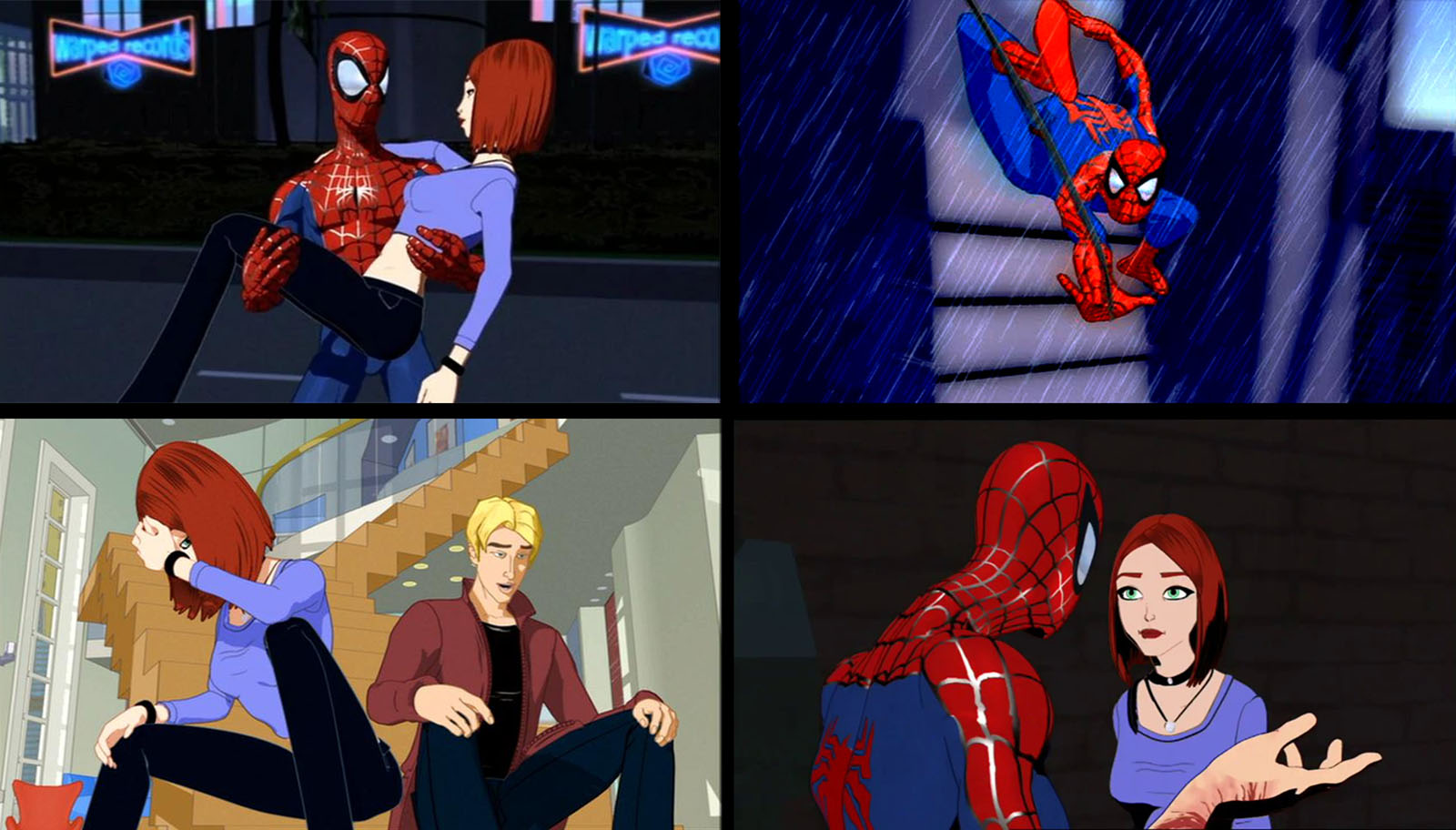
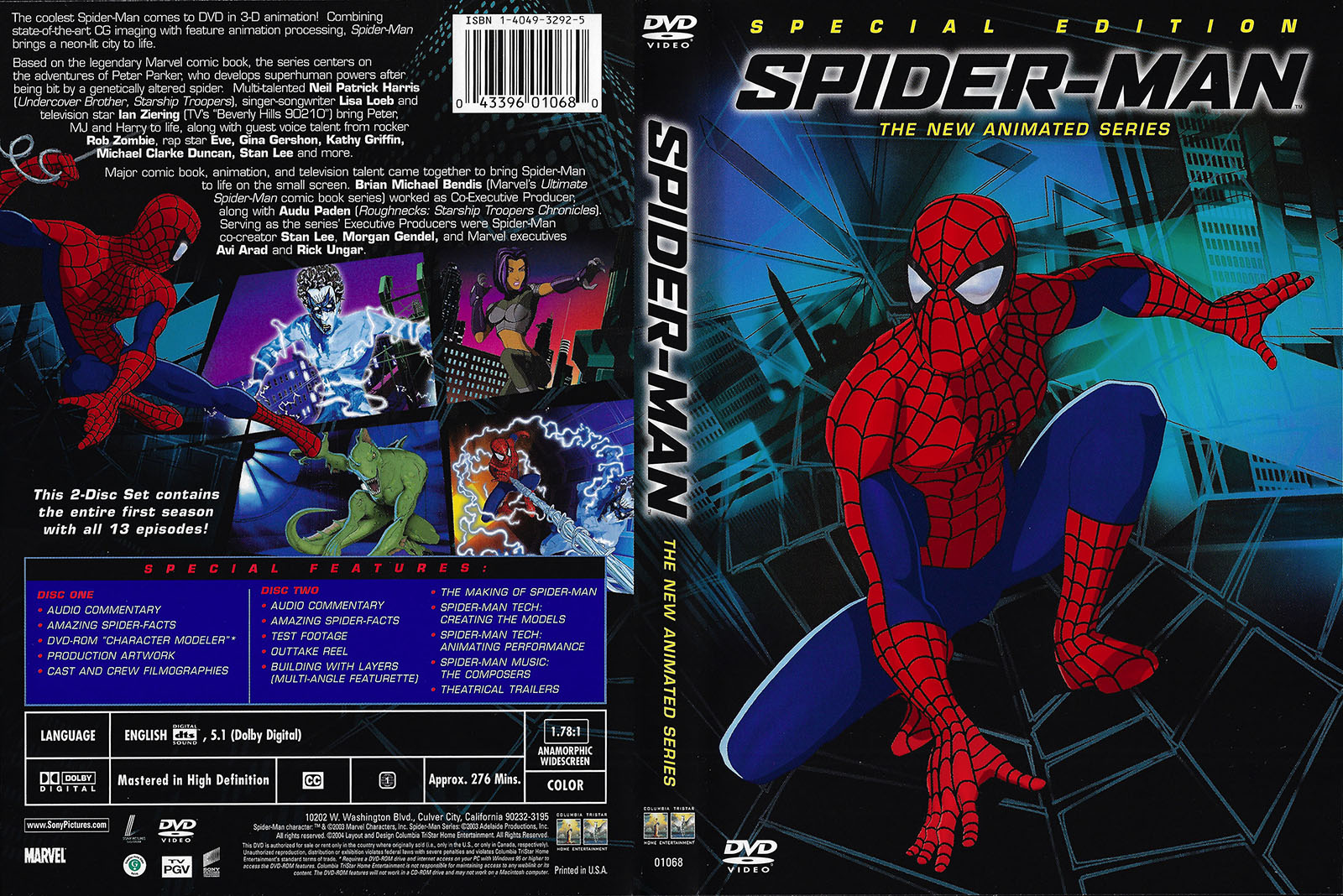
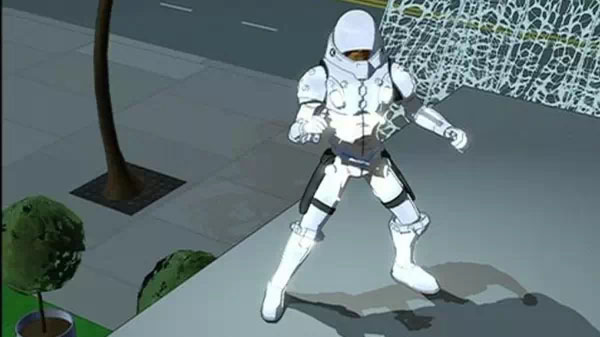
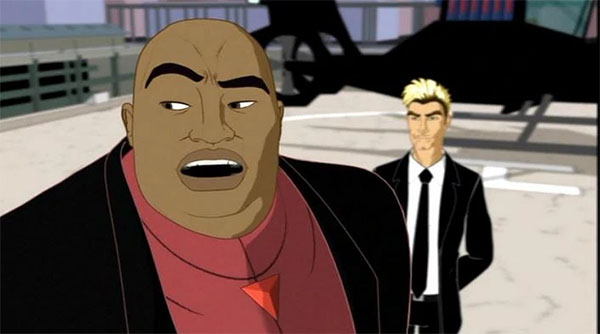
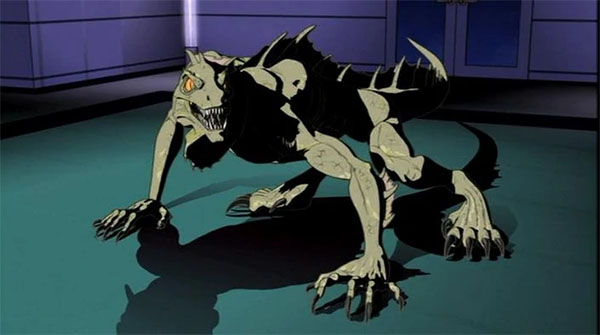
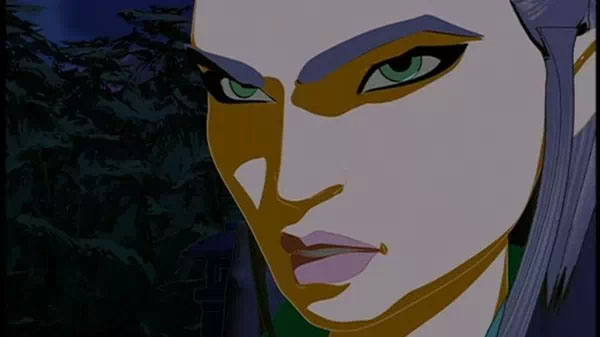
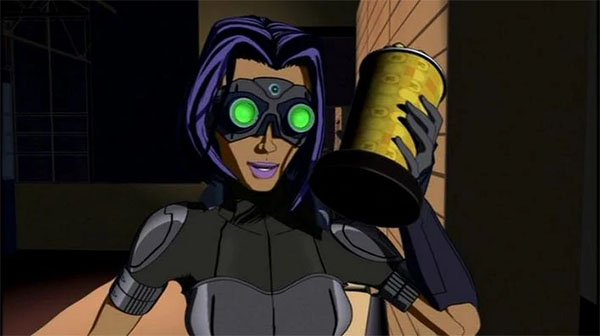
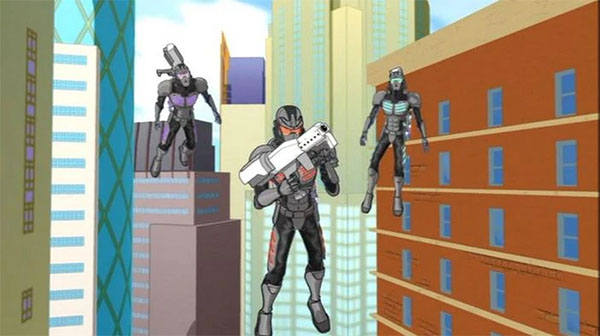
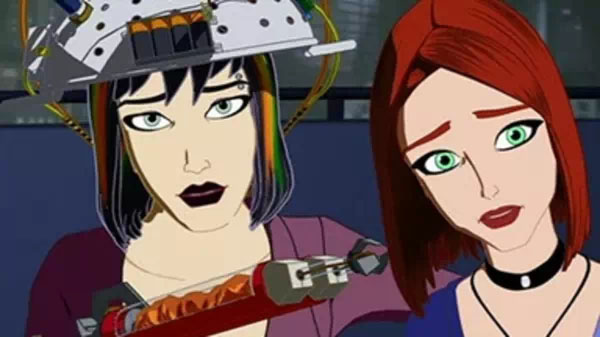
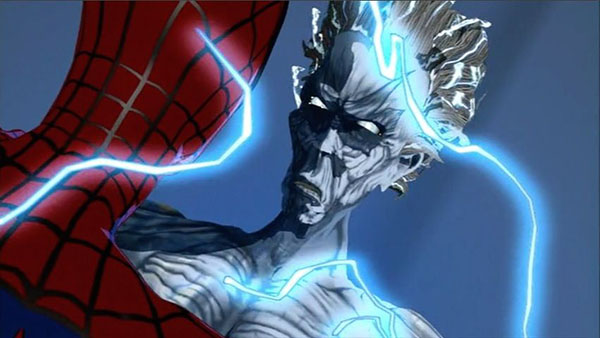
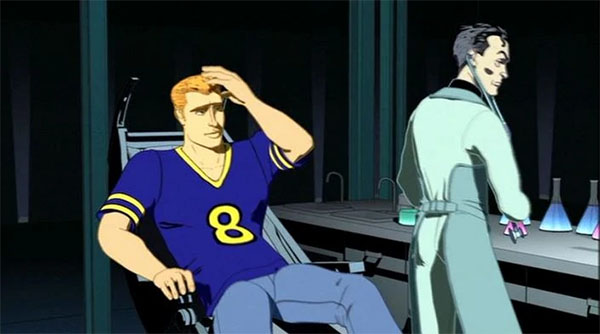
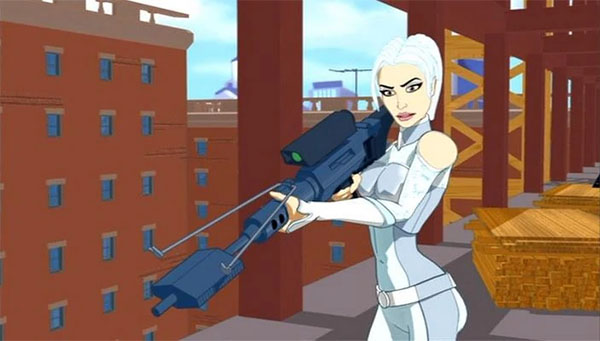
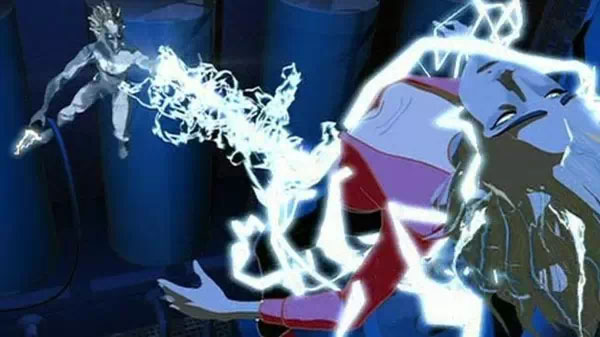
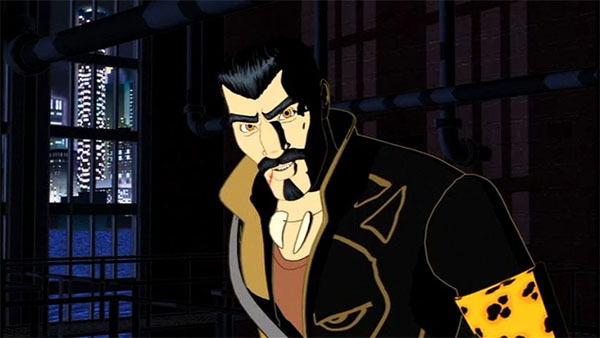
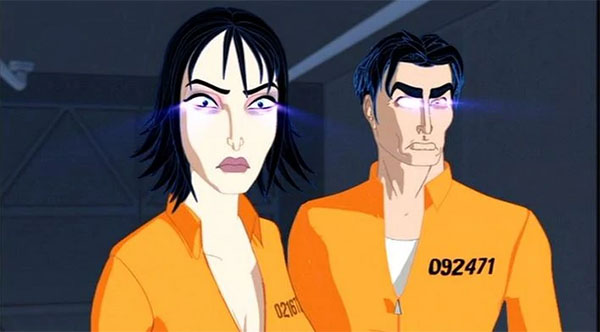
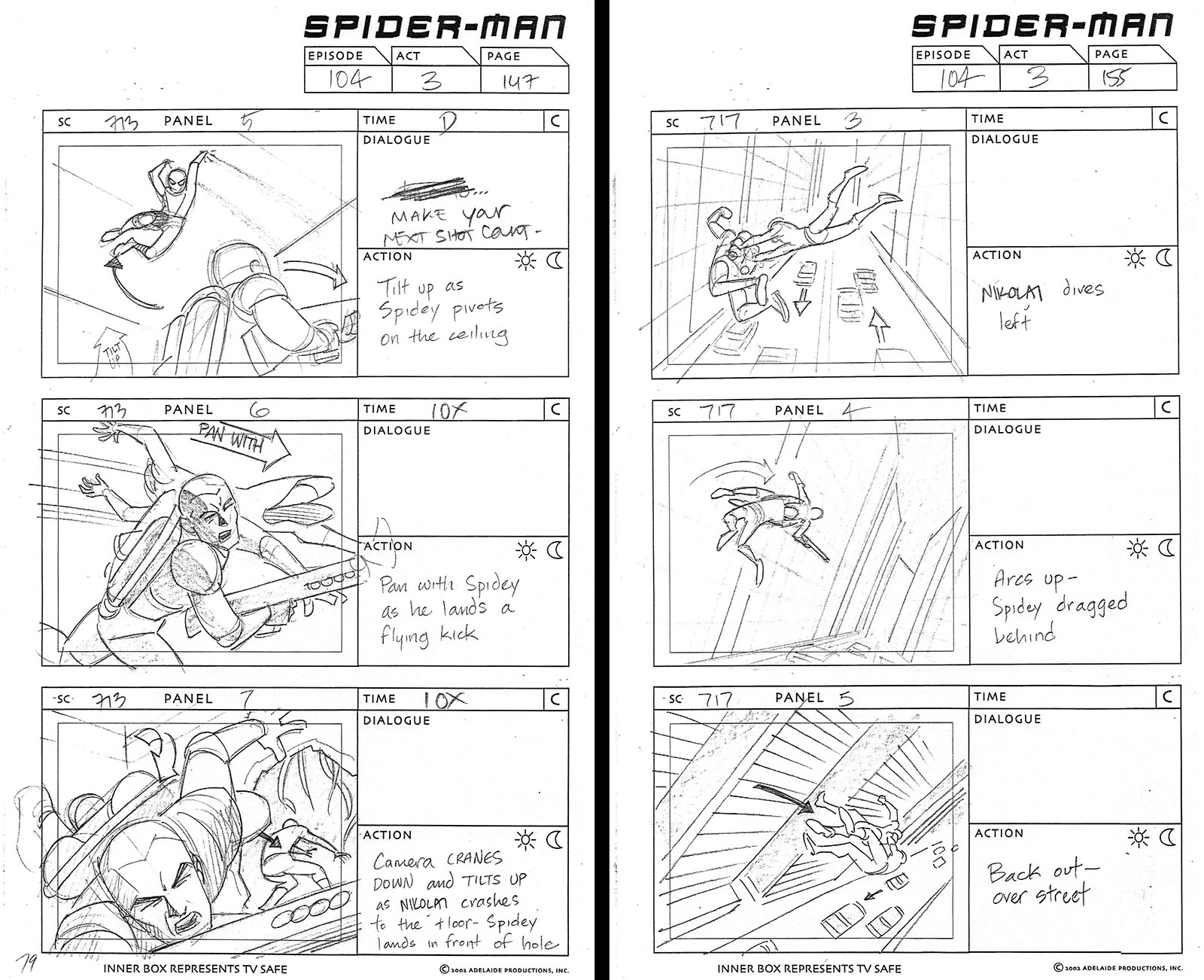
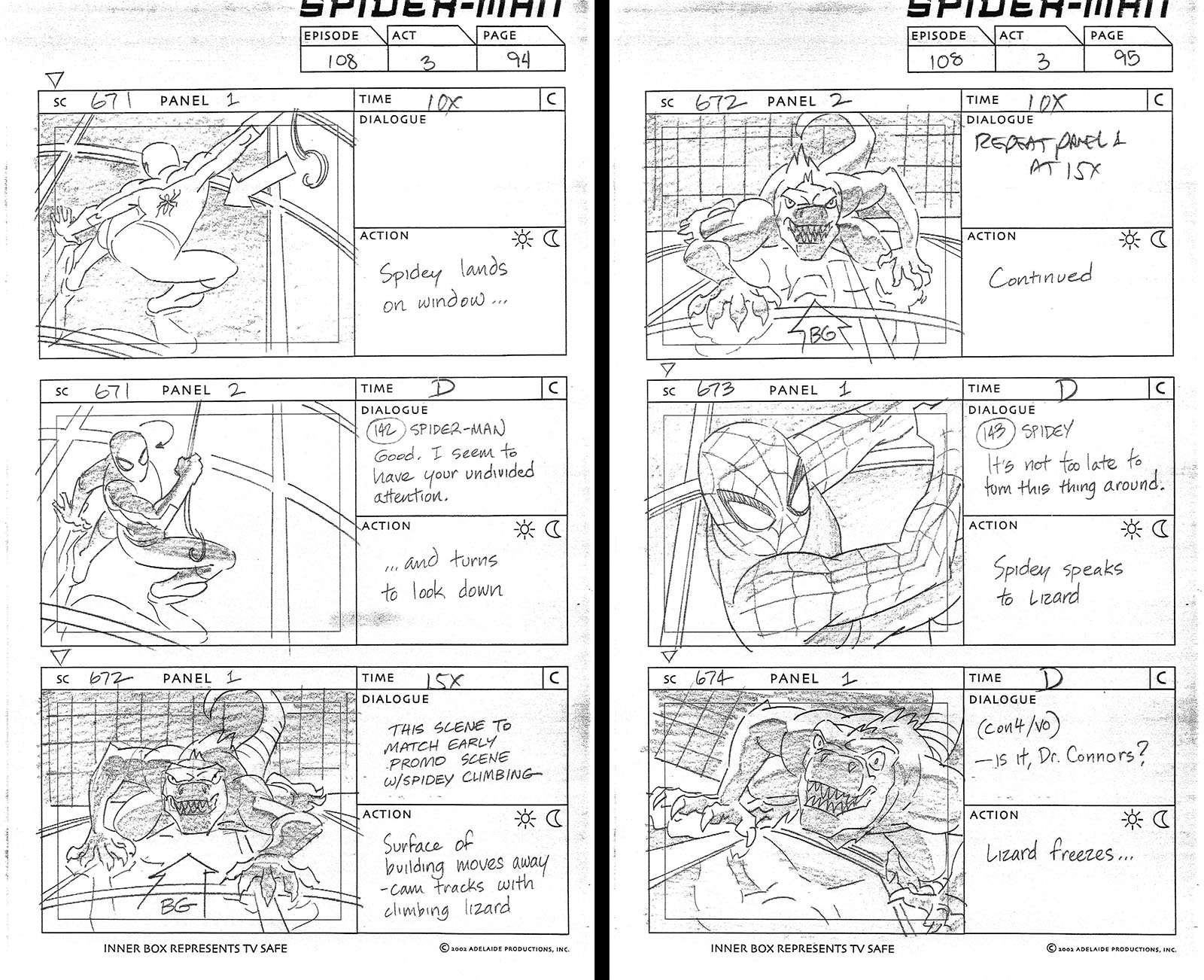
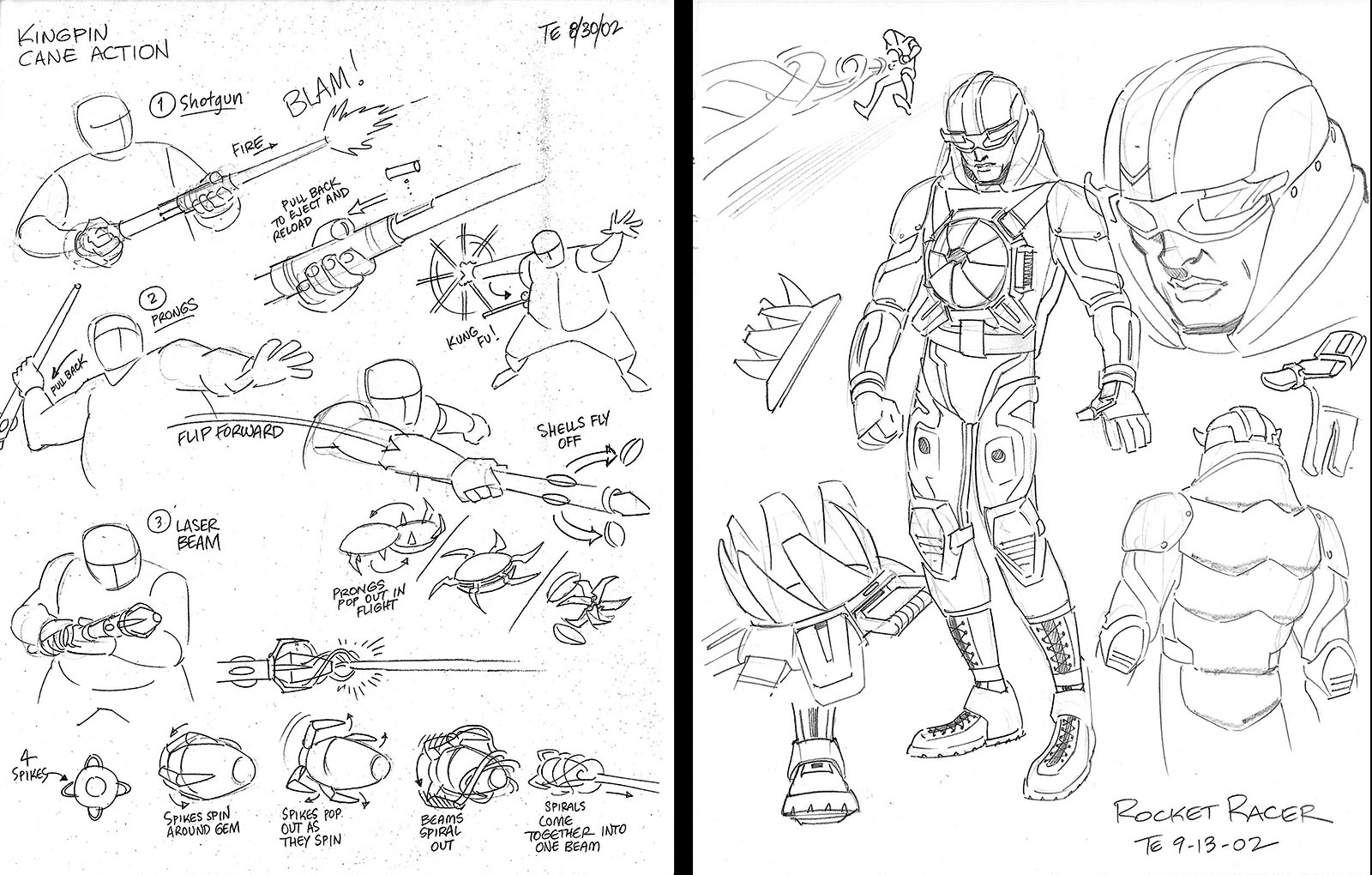
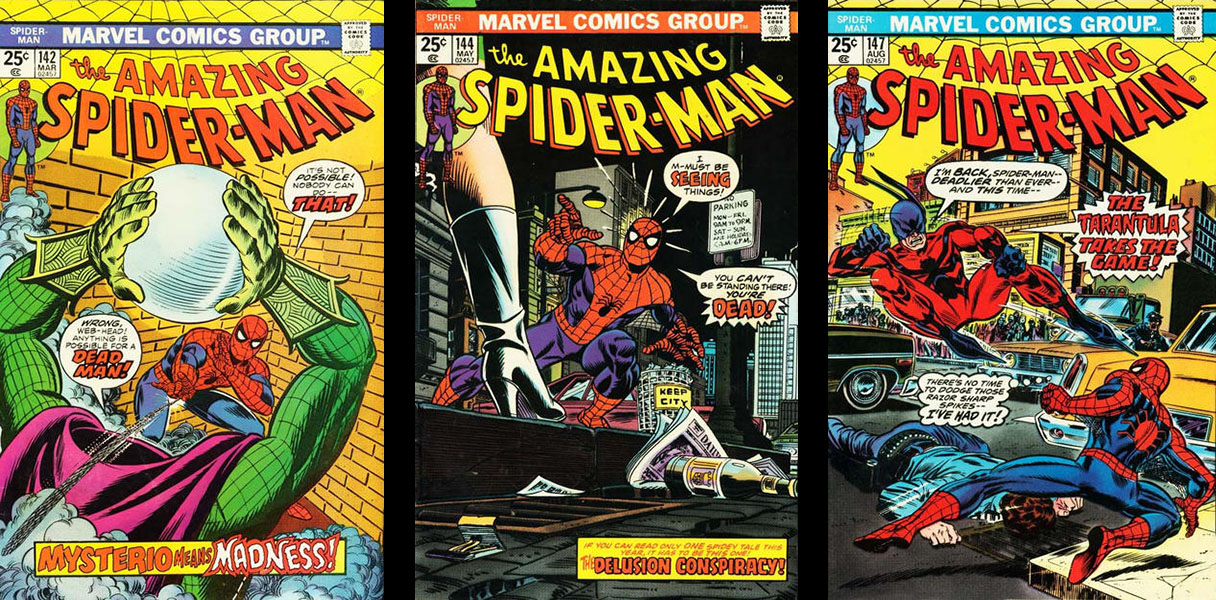
Awesome shit but you’re using a fan render towards the middle of the page. Specifically this image http://timeldred.com/media/update10/sm200310x.JPG
It says a lot about the quality of that render, if I couldn’t tell the difference! Thanks, fixed.
Hey Tim, thanks for sharing all this great behind the scenes material! Do you by chance remember if the scrapped storyboarded episode involved the character “Geldhoff?” Versions of him and some morlock character designs show up a lot in the bonus features on the DVD and they’re nowhere in the show, so I’m wondering if the story revolved around them?
That doesn’t ring a bell, but I didn’t work on the entire episode so my memory of it is sketchy.
Was there any list of villains that were planned for a season 2???
I never had contact with anyone on the writing side, so I don’t know if anything was discussed for season 2. I’m sure there was speculation (there always is), I just wasn’t in a position to hear about it.
In an interview Brandon Vietti commented that for a second season he had in mind the return of Shikata, an episode with Kraven and the introduction of Mysterio and Vulture
https://marvel.popgeeks.com/spideytac/interviews/vietti/
Thank you for sharing all of this behind the scenes info. I absolutely love this series and it saddens me that it never got past season 1. Now I at least have some vague idea as to why it didn’t happen.
Wish you the best of luck in your future projects.
No charge, Patrik!